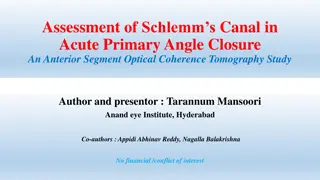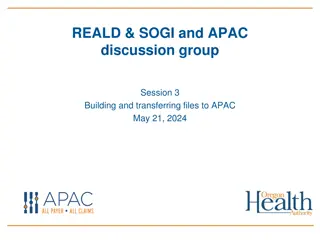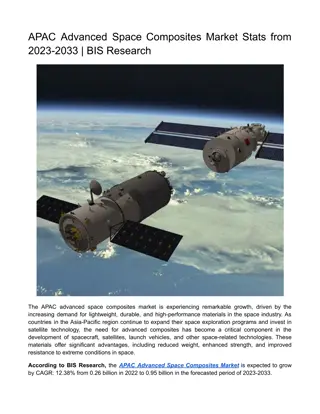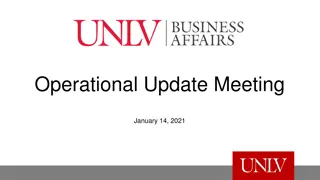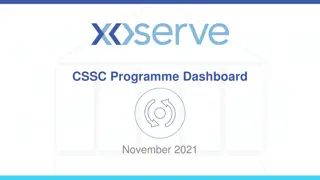
High-Level Overview of APAC Activities in Wi-Fi and WPAN, Jan. 2021
This slide deck by Edward Au of Huawei Technologies provides insights into APAC activities related to Wi-Fi and WPAN between November 2020 and January 2021. It covers updates on low interference potential devices in Australia by ACMA, including new arrangements supporting 5G and IoT technologies, as well as a frequency allocation update by Hong Kong's OFCA. Stay informed about the latest developments in the APAC region regarding wireless technologies.
Download Presentation

Please find below an Image/Link to download the presentation.
The content on the website is provided AS IS for your information and personal use only. It may not be sold, licensed, or shared on other websites without obtaining consent from the author. If you encounter any issues during the download, it is possible that the publisher has removed the file from their server.
You are allowed to download the files provided on this website for personal or commercial use, subject to the condition that they are used lawfully. All files are the property of their respective owners.
The content on the website is provided AS IS for your information and personal use only. It may not be sold, licensed, or shared on other websites without obtaining consent from the author.
E N D
Presentation Transcript
January 2021 doc.: IEEE 802.18-21/0001-00 APAC update January 2021 Author: Name Company Address Phone Email Edward Au Huawei Technologies edward.ks.au@gmail.com Submission Slide 1 Edward Au (Huawei)
January 2021 doc.: IEEE 802.18-21/0001-00 Background This slide deck provides a high-level overview of the activities in APAC (related to Wi-Fi and WPAN) between November 2020 and January 2021. Submission Slide 2 Edward Au (Huawei)
January 2021 doc.: IEEE 802.18-21/0001-00 Australia ACMA (1) RECAP: New arrangements for low interference potential devices Information: https://www.acma.gov.au/sites/default/files/2020-09/Variation-to- the-LIPD-Class-Licence-consultation-paper.docx https://www.acma.gov.au/sites/default/files/2020-09/Draft- Radiocommunications-Low-Interference-Potential-devices-Class- Licence-Variation-Notice-2020-No-1.docx https://www.acma.gov.au/sites/default/files/2020-09/Notice-under- subsection-136-of-Radiocommunications-Act-1992-of-proposed- variation-of-LIPD-Class-Licence-2015.docx Consultation closes on October 26, 2020 Submission Slide 3 Edward Au (Huawei)
January 2021 doc.: IEEE 802.18-21/0001-00 Australia ACMA (2) RECAP: New arrangements for low interference potential devices (Cont d) Abstract ACMA plans to introduce new arrangements to support 5G, the IoT and other new technologies related to the following spectrum bands by updating the Radiocommunications (Low Interference Potential Devices) Class Licence 2015 (a.k.a. LIPD Class License): Wireless broadband in the 24.25 25.10 GHz band IoT devices in the 928 935 MHz band and VHF high bands Radiodetermination devices in the 10.50 10.55 GHz band. Submission Slide 4 Edward Au (Huawei)
January 2021 doc.: IEEE 802.18-21/0001-00 Australia ACMA (2) New arrangements for low interference potential devices (Cont d) Decision is made on December 17, 2020 https://www.acma.gov.au/sites/default/files/2020-12/Variation-to- LIPD-Class-Licence_Summary-and-response-to-submissions.docx Of interests to us are: Proposed arrangements for the 928 935 MHz band will proceed in line with the draft LIPD Class Licence variation provided in the consultation process. The inclusion of a definition of indoor that would apply to the whole LIPD Class Licence in the next update to this instrument is under investigation: Indoor operation is limited to an area enclosed by permanent walls on all sides and having a permanent roof Submission Slide 5 Edward Au (Huawei)
January 2021 doc.: IEEE 802.18-21/0001-00 Hong Kong OFCA (1) Updated table of frequency allocation Published on January 4, 2021 https://www.ofca.gov.hk/filemanager/ofca/common/Industry/broadc asting/hk_freq_table_en.pdf Compared with the April 2020 version, of interests to us are: The following footnote is updated from WRC-12 to WRC-19: The use of the bands 5150 - 5350 MHz and 5470 - 5725 MHz by the stations in the mobile except aeronautical mobile, service shall be in accordance with Resolution 229 (Rev.WRC-19) of the Radio Regulations Submission Slide 6 Edward Au (Huawei)
January 2021 doc.: IEEE 802.18-21/0001-00 Hong Kong OFCA (2) Updated table of frequency allocation Of interests to us are (Cont d): The following footnote is expanded with the outcome of WRC-19: In the band 5250 - 5350 MHz, stations in the mobile service shall not claim protection from the radiolocation service, the Earth exploration- satellite (active) and the space research (active) service. The radiolocation service, the Earth exploration-satellite service (active) and the space research service (active) shall not impose more stringent conditions upon the mobile service than those stipulated in Resolution 229 (Rev.WRC-19) of the Radio Regulations. Submission Slide 7 Edward Au (Huawei)
January 2021 doc.: IEEE 802.18-21/0001-00 Hong Kong OFCA (3) Updated table of frequency allocation Of interests to us are (Cont d): The following footnote is added with the outcome of WRC-19: In the frequency band 5470 - 5725 MHz, stations in the mobile service shall not claim protection from radiodetermination services. The radiodetermination services shall not impose more stringent conditions upon the mobile service than those stipulated in Resolution 229 (Rev.WRC-19) of the Radio Regulations. The status of the 66-71 GHz band allocation is updated from TO BE PLANNED to mobile with the addition of the following footnote: The frequency band 66 - 71 GHz is identified for use by administrations wishing to implement the terrestrial component of International Mobile Telecommunications (IMT). Submission Slide 8 Edward Au (Huawei)
January 2021 doc.: IEEE 802.18-21/0001-00 India DOT Notice for seeking comments for Roadmap for use of Radio Frequency Spectrum in India during next 10 years Information: https://dot.gov.in/sites/default/files/DoT%20Website%20notice%20for%20C omments%20on%20Spectrum%20Roadmap.pdf?download=1Consultation closes on January 13, 2021 Summary: What changes are required in current spectrum allocations? What frequency bands should be considered for IMT/5G and other uses? What spectrum allocations do you see in the next 10 years for India? Any other suggestion in this regard. Submission Slide 9 Edward Au (Huawei)
January 2021 doc.: IEEE 802.18-21/0001-00 Japan MIC (1) Frequency reorganization action plan (second revision) Report is available for download at: https://www.soumu.go.jp/main_content/000716599.pdf Information: This second revision is published based on the feedback it received from its recent consultation that is closed in early October. Summary: It plans to release 150 MHz spectrum in 5.3 GHz and 5.8 GHz for WLAN It also plans to proceed with technical studies, e.g., sharing conditions, between WLAN with other wireless systems in the 5925 MHz 7125 MHz band. It plans to allow UWB for outdoor use in 7584 MHz 8400 MHz. Submission Slide 10 Edward Au (Huawei)
January 2021 doc.: IEEE 802.18-21/0001-00 Japan MIC (2) Technical Conditions for Ultra Wideband Wireless Systems Information https://www.soumu.go.jp/menu_news/s-news/01kiban14_02000477.html Consultation closes on December 24, 2020. Summary: This report summarizes the trends in outdoor use of UWB systems (including a brief mention of 802.15.4a and its spectral mask) (c.f., Chapter 1) its forecasts in the deployment of UWB systems in Japan and other countries (c.f., Chapter 2) sharing conditions between UWB and other wireless systems (c.f., Chapter 3) the proposed technical requirements for operating UWB outdoors in 7250-9000 MHz band (c.f., Chapter 4). Submission Slide 11 Edward Au (Huawei)
January 2021 doc.: IEEE 802.18-21/0001-00 Japan MIC (3) Technical Conditions for Ultra Wideband Wireless Systems General conditions The width between the outermost frequencies (fL, fH; fL < fH), which is 10 dB lower than the maximum radiation frequency (fM), is the bandwidth (B-10), and has a bandwidth of 450 MHz or more. A UWB radio system is one in which the bandwidth is divided by the center frequency (fC) and the bandwidth ratio ( -10) is 0.2 or more. Regarding the method of changing the center frequency of the emitted radio waves such as frequency hopping and chirp, UWB radio has a bandwidth of 450 MHz or more that radiates power instantly or a bandwidth ratio of 0.2 or more. B-10 = fH - fL -10= B-10/fC fC = (fH + fL )/2 Slide 12 Submission Edward Au (Huawei)
January 2021 doc.: IEEE 802.18-21/0001-00 Japan MIC (4) Technical Conditions for Ultra Wideband Wireless Systems General conditions (Cont d) Use of frequency bands The frequency band used for outdoor UWB wireless systems is 7.250 GHz to 9.0 GHz. Regarding the operation of UWB radio systems in the relevant frequency band, harmful interference to other radio systems shall not be allowed, and interference from these radio systems shall be tolerated. Antenna power To be consistent with the system for indoor use and sharing with other wireless systems, the antenna power is -41.3 dBm/MHz or less for average power, and 0dBm/50 MHz or less for peak power as EIRP. Submission Slide 13 Edward Au (Huawei)
January 2021 doc.: IEEE 802.18-21/0001-00 Japan MIC (5) Technical Conditions for Ultra Wideband Wireless Systems General conditions (Cont d) Communication and modulation types The communication can be simplex, duplex, or semi-duplex based on the usage pattern. The modulation is not limited. Bandwidth spread The frequency bandwidth, which is 10 dB lower than the maximum power point, is 450 MHz or more. This value may be updated subject to other regulations worldwide. Transmission speed There is no applicable limit. Submission Slide 14 Edward Au (Huawei)
January 2021 doc.: IEEE 802.18-21/0001-00 Japan MIC (6) Technical Conditions for Ultra Wideband Wireless Systems General conditions (Cont d) Interference avoidance When transmitting data, it must have a function to automatically transmit or receive an identification code. In addition, when performing radio localization, the reflected wave of the radio wave transmitted by the own radio station and the radio wave transmitted by another radio station can be discriminated by identifying the modulation method and other characteristics of the received radio wave. Submission Slide 15 Edward Au (Huawei)
January 2021 doc.: IEEE 802.18-21/0001-00 Japan MIC (7) Technical Conditions for Ultra Wideband Wireless Systems General conditions (Cont d) Terminal equipment that uses radio waves in the terminal equipment Similar to the current regulations: Those that use radio waves between one part and the other part that make up the terminal equipment shall have an identification code of 48 bits or more. Except in specific cases, the availability of radio waves to be used shall be determined, and the communication path shall be set only when the radio waves are available. Operational restrictions Within the range necessary to protect the existing radio system from harmful interference. Not allowed for operations in the sky. Submission Slide 16 Edward Au (Huawei)
January 2021 doc.: IEEE 802.18-21/0001-00 Japan MIC (8) Technical Conditions for Ultra Wideband Wireless Systems General conditions (Cont d) Termination capability Have a function to stop the emission of radio waves. Housing conditions As a countermeasure against illegal modification, the housing should have a structure that cannot be easily opened. Compliance with radio wave protection guidelines The maximum transmission power is 0.22 mW even when assuming a 3 GHz width of 7.25 GHz to 10.25 GHz that can be used indoors, and if the distance from the transmission antenna is 2.7 mm or more. When the distance is within 20 cm from the human body, it is necessary to comply with the local absorption guideline in the radio wave protection guideline. Submission Slide 17 Edward Au (Huawei)
January 2021 doc.: IEEE 802.18-21/0001-00 Japan MIC (9) Technical Conditions for Ultra Wideband Wireless Systems General conditions (Cont d) Electromagnetic environment measures Sufficient consideration must be given to mutual electromagnetic interference between UWB wireless systems and medical electronic devices. Technical conditions for radio equipment Transmitter The occupied frequency bandwidth shall be within 1.75 GHz including the frequency tolerance. For unnecessary emission, the outside of the frequency band is the spurious region, and the permissible value of the intensity of unnecessary emission in the spurious region is as shown in Table 4-1. Submission Slide 18 Edward Au (Huawei)
January 2021 doc.: IEEE 802.18-21/0001-00 Japan MIC (10) Frequency (MHz) Average power Peak power < 1600 < -90.0dBm/MHz < -84.0dBm/MHz 1600~2700 < -85.0dBm/MHz < -79.0dBm/MHz 2700~7250 < -70.0dBm/MHz < -64.0dBm/MHz 7250~9000 < -59.3dBm/MHz < -35.0dBm/MHz 9000~10250 < -60.0dBm/MHz < -35.7dBm/MHz 10250~10600 < -70.0dBm/MHz < -64.0dBm/MHz 10600~10700 < -85.0dBm/MHz < -79.0dBm/MHz 10700~11700 < -70.0dBm/MHz < -64.0dBm/MHz 11700~12750 < -85.0dBm/MHz < -79.0dBm/MHz > 12750 < -70.0dBm/MHz < -64.0dBm/MHz Submission Slide 19 Edward Au (Huawei)
January 2021 doc.: IEEE 802.18-21/0001-00 Japan MIC (11) Technical Conditions for Ultra Wideband Wireless Systems Technical conditions for radio equipment (Cont d) Transmitter (Cont d) The reference bandwidth in the allowable value of the intensity of unwanted emission shall be 1 MHz. The EIRP is less than or equal to the permissible value of the intensity of unwanted emission. Receiver The equivalent isotropic radiated power is -54 dBm/MHz or less, and other frequencies shall be below the allowable value of the intensity of unnecessary emission. Submission Slide 20 Edward Au (Huawei)
January 2021 doc.: IEEE 802.18-21/0001-00 Malaysia MCMC (1) Updated class assignment Information https://www.skmm.gov.my/skmmgovmy/media/General/pdf/CLASS -ASSIGNMENT-NO-1-OF-2020.pdf Of interest to us: Class assignment for Short Range Radiocommunications device Class assignment for Ultra Wide-Band communication device Submission Slide 21 Edward Au (Huawei)
January 2021 doc.: IEEE 802.18-21/0001-00 Malaysia MCMC (2) Of interest to us: Class assignment for short range radiocommunications device Submission Slide 22 Edward Au (Huawei)
January 2021 doc.: IEEE 802.18-21/0001-00 Malaysia MCMC (3) Of interest to us: Class assignment for Ultra Wide-Band communication device Submission Slide 23 Edward Au (Huawei)
January 2021 doc.: IEEE 802.18-21/0001-00 Vietnam MIC (1) Draft Decision amending and supplementing the National plan on radio frequency spectrum Information https://mic.gov.vn/Upload_Moi/DuThaoVanBan/HO-SO-DANG- WEBSITE.ZIP Consultation closes on February 2, 2021. Abstract: Following the decision of WRC-19, the MIC proposes the followings: Consider, amend, supplement division for radio operations for 18 frequency bands; Revised 60 annotations; Added 26 new captions; Dropped 6 annotations. Submission Slide 24 Edward Au (Huawei)
January 2021 doc.: IEEE 802.18-21/0001-00 Vietnam MIC (2) Draft Decision amending and supplementing the National plan on radio frequency spectrum (Cont d) Of possible interest to us: Identify 66-71 GHz for IMT VTN24: The bands 24.25 to 27.5 GHz; 37-43.5 GHz; 45.5-47 GHz; 47.2-48.2 GHz, 66-71 GHz are intended for IMT mobile communication systems. The manufacture and import of radio equipment for use in Vietnam in these frequency bands must comply with this regulation and other relevant laws. Submission Slide 25 Edward Au (Huawei)
January 2021 doc.: IEEE 802.18-21/0001-00 Vietnam MIC (3) Draft Decision amending and supplementing the National plan on radio frequency spectrum (Cont d) Of possible interest to us: Revise conditions for Wi-Fi/RLAN devices to be operated in 5150- 5250 MHz band such that the use of Wi-Fi/RLAN devices can be extended to use inside trains, cars, and outdoors. VTN14: Business Mobility in the 5150-5350 MHz bands; 5470-5725 MHz and 5725-5850 MHz are only limited to deploying radio access systems (WAS) including wireless LANs (WLANs). The use of the 5150-5250 MHz band for WiFi / RLAN inside trains, cars and outdoor use is subject to the provisions of Resolution 229 (WRC-19). Submission Slide 26 Edward Au (Huawei)





